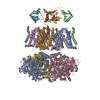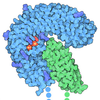[English] 日本語
 Yorodumi
Yorodumi- EMDB-33977: Cryo-EM structure of human Slo1-LRRC26 complex with Symmetry Expansion -
+ Open data
Open data
- Basic information
Basic information
| Entry |  | |||||||||
|---|---|---|---|---|---|---|---|---|---|---|
| Title | Cryo-EM structure of human Slo1-LRRC26 complex with Symmetry Expansion | |||||||||
 Map data Map data | ||||||||||
 Sample Sample |
| |||||||||
 Keywords Keywords | TRANSPORT PROTEIN | |||||||||
| Function / homology |  Function and homology information Function and homology informationpositive regulation of voltage-gated potassium channel activity / monoatomic ion-gated channel activity / potassium channel activator activity / ligand-gated monoatomic cation channel activity / voltage-gated potassium channel activity / potassium channel activity / potassium channel regulator activity / voltage-gated potassium channel complex / potassium ion transmembrane transport / transmembrane transporter binding ...positive regulation of voltage-gated potassium channel activity / monoatomic ion-gated channel activity / potassium channel activator activity / ligand-gated monoatomic cation channel activity / voltage-gated potassium channel activity / potassium channel activity / potassium channel regulator activity / voltage-gated potassium channel complex / potassium ion transmembrane transport / transmembrane transporter binding / cytoskeleton / extracellular exosome / membrane / plasma membrane / cytoplasm Similarity search - Function | |||||||||
| Biological species |  Homo sapiens (human) Homo sapiens (human) | |||||||||
| Method | single particle reconstruction / cryo EM / Resolution: 3.6 Å | |||||||||
 Authors Authors | Yamanouchi D / Nureki O | |||||||||
| Funding support |  Japan, 1 items Japan, 1 items
| |||||||||
 Citation Citation |  Journal: To Be Published Journal: To Be PublishedTitle: Structural basis for dual allosteric gating modulation of Slo1-LRRC channel complex Authors: Yamanouchi D | |||||||||
| History |
|
- Structure visualization
Structure visualization
| Supplemental images |
|---|
- Downloads & links
Downloads & links
-EMDB archive
| Map data |  emd_33977.map.gz emd_33977.map.gz | 14.5 MB |  EMDB map data format EMDB map data format | |
|---|---|---|---|---|
| Header (meta data) |  emd-33977-v30.xml emd-33977-v30.xml emd-33977.xml emd-33977.xml | 15.8 KB 15.8 KB | Display Display |  EMDB header EMDB header |
| FSC (resolution estimation) |  emd_33977_fsc.xml emd_33977_fsc.xml | 10.7 KB | Display |  FSC data file FSC data file |
| Images |  emd_33977.png emd_33977.png | 95.3 KB | ||
| Masks |  emd_33977_msk_1.map emd_33977_msk_1.map | 103 MB |  Mask map Mask map | |
| Filedesc metadata |  emd-33977.cif.gz emd-33977.cif.gz | 6.4 KB | ||
| Others |  emd_33977_half_map_1.map.gz emd_33977_half_map_1.map.gz emd_33977_half_map_2.map.gz emd_33977_half_map_2.map.gz | 81.1 MB 81.1 MB | ||
| Archive directory |  http://ftp.pdbj.org/pub/emdb/structures/EMD-33977 http://ftp.pdbj.org/pub/emdb/structures/EMD-33977 ftp://ftp.pdbj.org/pub/emdb/structures/EMD-33977 ftp://ftp.pdbj.org/pub/emdb/structures/EMD-33977 | HTTPS FTP |
-Validation report
| Summary document |  emd_33977_validation.pdf.gz emd_33977_validation.pdf.gz | 1004.3 KB | Display |  EMDB validaton report EMDB validaton report |
|---|---|---|---|---|
| Full document |  emd_33977_full_validation.pdf.gz emd_33977_full_validation.pdf.gz | 1003.8 KB | Display | |
| Data in XML |  emd_33977_validation.xml.gz emd_33977_validation.xml.gz | 17.6 KB | Display | |
| Data in CIF |  emd_33977_validation.cif.gz emd_33977_validation.cif.gz | 22.9 KB | Display | |
| Arichive directory |  https://ftp.pdbj.org/pub/emdb/validation_reports/EMD-33977 https://ftp.pdbj.org/pub/emdb/validation_reports/EMD-33977 ftp://ftp.pdbj.org/pub/emdb/validation_reports/EMD-33977 ftp://ftp.pdbj.org/pub/emdb/validation_reports/EMD-33977 | HTTPS FTP |
-Related structure data
| Related structure data |  7yo0MC  7ynzC  7yo1C  7yo2C  7yo3C  7yo4C  7yo5C M: atomic model generated by this map C: citing same article ( |
|---|---|
| Similar structure data | Similarity search - Function & homology  F&H Search F&H Search |
- Links
Links
| EMDB pages |  EMDB (EBI/PDBe) / EMDB (EBI/PDBe) /  EMDataResource EMDataResource |
|---|---|
| Related items in Molecule of the Month |
- Map
Map
| File |  Download / File: emd_33977.map.gz / Format: CCP4 / Size: 103 MB / Type: IMAGE STORED AS FLOATING POINT NUMBER (4 BYTES) Download / File: emd_33977.map.gz / Format: CCP4 / Size: 103 MB / Type: IMAGE STORED AS FLOATING POINT NUMBER (4 BYTES) | ||||||||||||||||||||||||||||||||||||
|---|---|---|---|---|---|---|---|---|---|---|---|---|---|---|---|---|---|---|---|---|---|---|---|---|---|---|---|---|---|---|---|---|---|---|---|---|---|
| Projections & slices | Image control
Images are generated by Spider. | ||||||||||||||||||||||||||||||||||||
| Voxel size | X=Y=Z: 0.996 Å | ||||||||||||||||||||||||||||||||||||
| Density |
| ||||||||||||||||||||||||||||||||||||
| Symmetry | Space group: 1 | ||||||||||||||||||||||||||||||||||||
| Details | EMDB XML:
|
-Supplemental data
-Mask #1
| File |  emd_33977_msk_1.map emd_33977_msk_1.map | ||||||||||||
|---|---|---|---|---|---|---|---|---|---|---|---|---|---|
| Projections & Slices |
| ||||||||||||
| Density Histograms |
-Half map: #2
| File | emd_33977_half_map_1.map | ||||||||||||
|---|---|---|---|---|---|---|---|---|---|---|---|---|---|
| Projections & Slices |
| ||||||||||||
| Density Histograms |
-Half map: #1
| File | emd_33977_half_map_2.map | ||||||||||||
|---|---|---|---|---|---|---|---|---|---|---|---|---|---|
| Projections & Slices |
| ||||||||||||
| Density Histograms |
- Sample components
Sample components
-Entire : human Slo1-LRRC26 complex
| Entire | Name: human Slo1-LRRC26 complex |
|---|---|
| Components |
|
-Supramolecule #1: human Slo1-LRRC26 complex
| Supramolecule | Name: human Slo1-LRRC26 complex / type: complex / ID: 1 / Parent: 0 / Macromolecule list: #1-#2 |
|---|---|
| Source (natural) | Organism:  Homo sapiens (human) Homo sapiens (human) |
| Molecular weight | Theoretical: 616 kDa/nm |
-Macromolecule #1: Calcium-activated potassium channel subunit alpha-1
| Macromolecule | Name: Calcium-activated potassium channel subunit alpha-1 / type: protein_or_peptide / ID: 1 / Number of copies: 4 / Enantiomer: LEVO |
|---|---|
| Source (natural) | Organism:  Homo sapiens (human) Homo sapiens (human) |
| Molecular weight | Theoretical: 119.4585 KDa |
| Recombinant expression | Organism:  Homo sapiens (human) Homo sapiens (human) |
| Sequence | String: MDALIIPVTM EVPCDSRGQR MWWAFLASSM VTFFGGLFII LLWRTLKYLW TVCCHCGGKT KEAQKINNGS SQADGTLKPV DEKEEAVAA EVGWMTSVKD WAGVMISAQT LTGRVLVVLV FALSIGALVI YFIDSSNPIE SCQNFYKDFT LQIDMAFNVF F LLYFGLRF ...String: MDALIIPVTM EVPCDSRGQR MWWAFLASSM VTFFGGLFII LLWRTLKYLW TVCCHCGGKT KEAQKINNGS SQADGTLKPV DEKEEAVAA EVGWMTSVKD WAGVMISAQT LTGRVLVVLV FALSIGALVI YFIDSSNPIE SCQNFYKDFT LQIDMAFNVF F LLYFGLRF IAANDKLWFW LEVNSVVDFF TVPPVFVSVY LNRSWLGLRF LRALRLIQFS EILQFLNILK TSNSIKLVNL LS IFISTWL TAAGFIHLVE NSGDPWENFQ NNQALTYWEC VYLLMVTMST VGYGDVYAKT TLGRLFMVFF ILGGLAMFAS YVP EIIELI GNRKKYGGSY SAVSGRKHIV VCGHITLESV SNFLKDFLHK DRDDVNVEIV FLHNISPNLE LEALFKRHFT QVEF YQGSV LNPHDLARVK IESADACLIL ANKYCADPDA EDASNIMRVI SIKNYHPKIR IITQMLQYHN KAHLLNIPSW NWKEG DDAI CLAELKLGFI AQSCLAQGLS TMLANLFSMR SFIKIEEDTW QKYYLEGVSN EMYTEYLSSA FVGLSFPTVC ELCFVK LKL LMIAIEYKSA NRESRSRSRI LINPGNHLKI QEGTLGFFIA SDAKEVKRAF FYCKACHDDI TDPKRIKKCG CKRLEDE QP STLSPKKKQR NGGMRNSPNT SPKLMRHDPL LIPGNDQIDN MDSNVKKYDS TGMFHWCAPK EIEKVILTRS EAAMTVLS G HVVVCIFGDV SSALIGLRNL VMPLRASNFH YHELKHIVFV GSIEYLKREW ETLHNFPKVS ILPGTPLSRA DLRAVNINL CDMCVILSAN QNNIDDTSLQ DKECILASLN IKSMQFDDSI GVLQANSQGF TPPGMDRSSP DNSPVHGMLR QPSITTGVNI PIITELVND TNVQFLDQDD DDDPDTELYL TQPFACGTAF AVSVLDSLMS ATYFNDNILT LIRTLVTGGA TPELEALIAE E NALRGGYS TPQTLANRDR CRVAQLALLD GPFADLGDGG CYGDLFCKAL KTYNMLCFGI YRLRDAHLST PSQCTKRYVI TN PPYEFEL VPTDLIFCLM QFD UniProtKB: Calcium-activated potassium channel subunit alpha-1 |
-Macromolecule #2: Leucine-rich repeat-containing protein 26
| Macromolecule | Name: Leucine-rich repeat-containing protein 26 / type: protein_or_peptide / ID: 2 / Number of copies: 4 / Enantiomer: LEVO |
|---|---|
| Source (natural) | Organism:  Homo sapiens (human) Homo sapiens (human) |
| Molecular weight | Theoretical: 34.893629 KDa |
| Recombinant expression | Organism:  Homo sapiens (human) Homo sapiens (human) |
| Sequence | String: MRGPSWSRPR PLLLLLLLLS PWPVWAQVSA TASPSGSLGA PDCPEVCTCV PGGLASCSAL SLPAVPPGLS LRLRALLLDH NRVRALPPG AFAGAGALQR LDLRENGLHS VHVRAFWGLG ALQLLDLSAN QLEALAPGTF APLRALRNLS LAGNRLARLE P AALGALPL ...String: MRGPSWSRPR PLLLLLLLLS PWPVWAQVSA TASPSGSLGA PDCPEVCTCV PGGLASCSAL SLPAVPPGLS LRLRALLLDH NRVRALPPG AFAGAGALQR LDLRENGLHS VHVRAFWGLG ALQLLDLSAN QLEALAPGTF APLRALRNLS LAGNRLARLE P AALGALPL LRSLSLQDNE LAALAPGLLG RLPALDALHL RGNPWGCGCA LRPLCAWLRR HPLPASEAET VLCVWPGRLT LS PLTAFSD AAFSHCAQPL ALRDLAVVYT LGPASFLVSL ASCLALGSGL TACRARRRRL RTAALRPPRP PDPNPDPDPH GCA SPADPG SPAAAAQA UniProtKB: Leucine-rich repeat-containing protein 26 |
-Macromolecule #3: (1R)-2-{[(S)-{[(2S)-2,3-dihydroxypropyl]oxy}(hydroxy)phosphoryl]o...
| Macromolecule | Name: (1R)-2-{[(S)-{[(2S)-2,3-dihydroxypropyl]oxy}(hydroxy)phosphoryl]oxy}-1-[(hexadecanoyloxy)methyl]ethyl (9Z)-octadec-9-enoate type: ligand / ID: 3 / Number of copies: 4 / Formula: PGW |
|---|---|
| Molecular weight | Theoretical: 749.007 Da |
-Macromolecule #4: MAGNESIUM ION
| Macromolecule | Name: MAGNESIUM ION / type: ligand / ID: 4 / Number of copies: 4 / Formula: MG |
|---|---|
| Molecular weight | Theoretical: 24.305 Da |
-Macromolecule #5: CALCIUM ION
| Macromolecule | Name: CALCIUM ION / type: ligand / ID: 5 / Number of copies: 8 / Formula: CA |
|---|---|
| Molecular weight | Theoretical: 40.078 Da |
-Experimental details
-Structure determination
| Method | cryo EM |
|---|---|
 Processing Processing | single particle reconstruction |
| Aggregation state | particle |
- Sample preparation
Sample preparation
| Concentration | 2.0 mg/mL |
|---|---|
| Buffer | pH: 8 |
| Vitrification | Cryogen name: ETHANE |
- Electron microscopy
Electron microscopy
| Microscope | FEI TITAN KRIOS |
|---|---|
| Image recording | Film or detector model: GATAN K3 (6k x 4k) / Average electron dose: 48.0 e/Å2 |
| Electron beam | Acceleration voltage: 300 kV / Electron source:  FIELD EMISSION GUN FIELD EMISSION GUN |
| Electron optics | Illumination mode: FLOOD BEAM / Imaging mode: BRIGHT FIELD / Nominal defocus max: 1.6 µm / Nominal defocus min: 0.8 µm |
| Experimental equipment |  Model: Titan Krios / Image courtesy: FEI Company |
 Movie
Movie Controller
Controller














 Z (Sec.)
Z (Sec.) Y (Row.)
Y (Row.) X (Col.)
X (Col.)













































